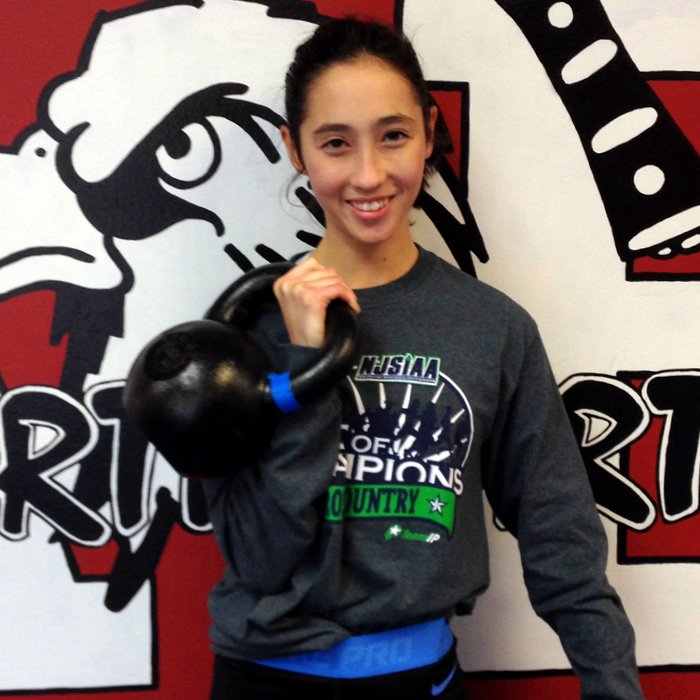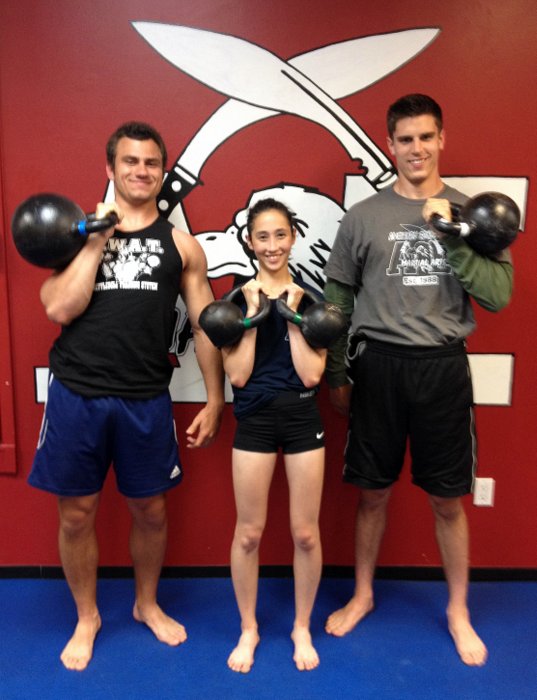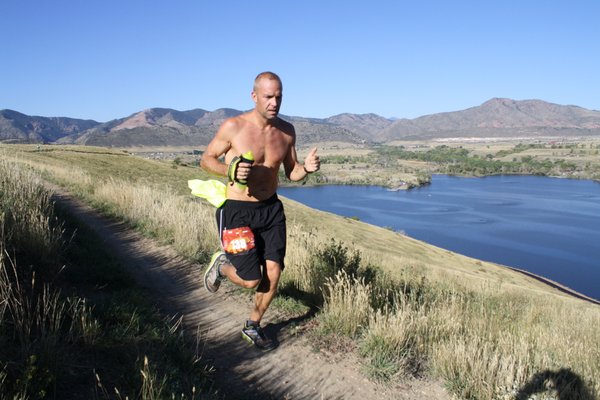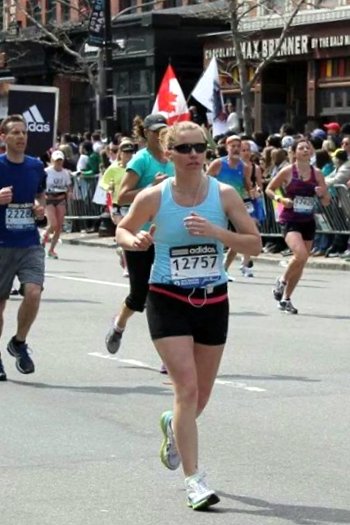
Over the past 22 months, Carleen Jeffers has amassed an incredible amount of championships—and has set distance running high school and county records that were previously unbroken for decades. Brown University bound, Jeffers didn’t even consider long distance running until the summer of 2013. But in the fall of that same year, she earned the honor of First Team All County for Cross Country in the incredibly competitive county of Bergen, NJ—population, one million. During her first season, she went from not running track to First Team All County! Some top-shelf athletes train their whole lives and never achieve that level of success in our county. Prior to running, Carleen played softball, trained in the martial arts for many years, and began swinging kettlebells about a year before track.
Many distance runners don’t like the idea of resistance training, but they need strength! While bodybuilding routines or powerlifting will usually be counter-productive, kettlebells and bodyweight training can also provide relief from the repetitive movements of running. Tendons and ligaments will also become stronger which can prevent injuries and/or lessen their severity. Diaphragm strength also increases, and will supply the muscles with more oxygen. The body will process lactic acid more efficiently, allowing an athlete to have a stronger kick at the end of a race. Becoming stronger also has psychological advantages. Obviously, kettlebell and bodyweight training makes a lot of sense for runners.
Even during her highest mileage training of more than 60 miles a week, Carleen was able to maintain her muscle mass and avoid injury. While teammates suffered from stress fractures, shin splits and other common overuse injuries, her season was uninterrupted.

She completed her senior year by placing 4th in the New Balance National High School track meet on June 19th, 2015, earning her High School All American status. Her performance of 16.58 in the 5K smashed both the former Bergen County and Ridgewood High School records and earned her Track Athlete of the Year for Northern New Jersey. That’s quite a few accomplishments for an athlete in a sport for only 22 months.
Carleen’s coach, Jacob C. Brown, of Ridgewood High School, is a coaching legend in the world of women’s track. He’s coached more champions and championship teams than virtually any other coach in the state of New Jersey. He advised her to keep training with kettlebells while she is in college—even if the college strength program doesn’t call for it. Coach Brown and I agree that that Carleen’s kettlebell training was the major differentiator in her success as a runner.
How did a 97 pound, 5’ 4” high school distance runner quickly achieve such a high level of success? Normally in track and field, athletes rarely improve from one contest to another, especially at higher levels of competition. The goal is to stay healthy while peaking for the States, Nationals or Worlds.

Many runners—along with many in the general population—have rounded shoulders and poor thoracic mobility. And this situation is acerbated by the form these athletes adopt while running. Instead, they need to open up their chests to expand their lung capacity and increase blood flow.
The following are examples of Carleen’s training with kettlebells as a track athlete. We generally cycle our weekly training.
Warm-Up and Mobility:
Each session includes a warm up of jumping rope for 3-5 minutes, and a mobility sequence. The mobility portion includes six posterior chain and shoulder mobility exercises performed with a bo staff or dowel, armbars, thoracic bridges, deck squats or some other squat, hip opening movements, zombie rolls, and push-ups, to name a few. We also employed crawling movements along with quad and hamstring stretching.
Power Days:
Heavy lifting with sets of 5 to 10 reps. We have Power Days within three or more days before an event. If it’s a major event, we’ll leave a week between power sessions. These sessions include heavy swings, sumo squats, double kettlebell squats and heavy presses, bottoms-up presses, heavy get-ups, floor presses, heavy rows, kettlebell carries, and complexes. We also perform low rep plyometric versions of some of these movements.
Endurance Days:
Endurance days include chains with 30 to 40 reps, and weighted plyometrics of 10 to 20 reps per set. With kettlebells, we perform walking figure-8 lunges, walking swings, over-speed eccentric swings, ladders, and VO2Max snatch workouts. If we don’t do a VO2Max workout, we’ll end with “6 Minutes of Hell” or 5 minutes of kettlebell snatches (similar to part of the RKC Workshop testing requirements).
An example of a “6 Minutes of Hell” variation: Perform a clean, press, and a squat as a chain for one minute on one side, then change to the other side for the next minute. Repeat this for 6 minutes.
After an endurance day, we would make sure to have at least two days of rest before an event. Sometimes we might do an endurance day workout the day before an event, but with reduced weights, so the athletes would not be too sore to compete. However, we wouldn’t have an endurance day before a big meet.
PowerDure Days:
A good 40 to 50% of our weekly workouts are based on the PowerDure method. We perform the first half of the workout using mid-range power sets. We’ll do 3 to 4 sets of a mobility exercise along with an upper body push and pull, and lower body push and pull. 8 to 10 reps per set. Sometimes unilateral, other times bilateral.
In PowerDure, grinds are our primary focus. The second half of the session is dedicated to muscular endurance, while maintaining our bracing and the lock and pop of our ballistic movements. We focus on chains and circuits using workouts like our “Warrior’s Challenge”, “Scrambled Eggs” (see example below), and Tabatas. Heart rates are high and so is the sweat production! Afterwards, we cool down with mobility and flexibility training. I have a pool of several hundred workouts in the PowerDure category.
Bodyweight Days: These are performed once a week, especially close to the meets and sometimes the day before. We will either train with low reps (1 to 5) for strength or we will use timed circuits, moving from one exercise to the next while trying to hit 80% of our max reps. Generally, our bodyweight circuits are timed at 50 seconds on, 10 seconds off. We usually do 9 exercises for 5 rotations. During strength (low rep) days, we’ll challenge ourselves with the most difficult exercises. On bodyweight days, we always revert to regressions when the reps of the more difficult movements are no longer achievable. I find the bodyweight-only days round out the training since bodyweight exercises also improve balance and overall coordination.

Example PowerDure workout with an intermediate variation of “Scrambled Eggs”
Our “Scrambled Eggs” circuit requires anywhere from 6 to 8 minutes to complete prior to the 1 minute rest between sets. There is no rest between the exercises, only one minute rest at the end of each set. This type of training prepares the body to deal with the lactic acid produced during sports or other strenuous activities.
Circuit 1: 2 sets
- Two-hand kettlebell swings: 50 reps
- Armbars: 10 each side
- Side Press: 10 each side
Scrambled Eggs (1 kettlebell): 3 sets
- Two-hand swings: 20 reps
- Hand-to-hand swing: 10 reps each side
- Snatches: 10 each side
- High pulls: 10 each side
- Swing squats: 10 reps
- Waiter press: 5 each side
- Single-leg deadlift: 5 reps each side
- Bottoms-up press: 5 reps each side
- One minute of rest
Strength and Honor!
Coach Phil
****
For more information on Master RKC Phil Ross’s strength and conditioning programs, videos (including The Kettlebell Workout Library), and workshops, please visit www.philross.com. Coach Jacob Brown’s website is available at jacobbrown.com. View Carleen Jeffers’ MileSplit profile.

